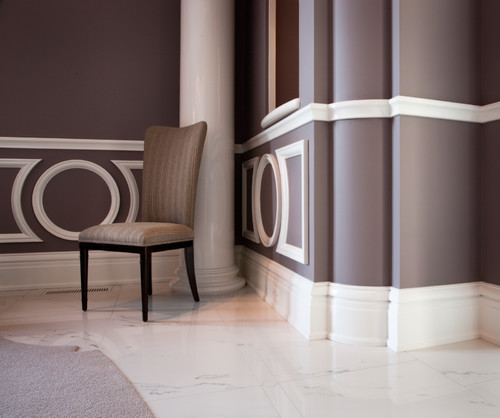A chair rail affects the visual aspect of the room. The chair rail will emphasize the length and reduce the sense of height. Rails are usually 2 ½ to 3 feet from the floor and can contribute visibly to a room’s design.

Photo by Robert J Erdmann Design, LLC – More dining room photos
Traditionally, chair rail was designed to protect walls from damage, as a practical way to prevent scarring walls with bumps and bangs from chairs in the dining room.
Usually, the surface below any chair rail is covered with wood panels for this reason. And the style possibilities expanded as people began to install paneling and bead board on the wall below the chair rail.
Today, chair rails are used for the purpose of interior decoration. It helps to divide a large wall into different section. A chair rail is a piece of molding made of wood, plastic, metal or composite. They can add an extraordinary effect to the walls and your room.
Chair Rail Ideas
Install a chair rail in a room and that room will change it for sure. A lot of people liked chair rail molding ideas. Changing a room look with this method is very popular because you do it with a low budget and fast installation procedures.
There are plenty of chair rail ideas for decorative purposes. Chair rails ideas can certainly cover a wide range of design goals. Whether searching for classic or kits, chair molding gives an effective horizontal aspect to room styles, as well as supplying a excellent scheme to help preserve the condition of the wall a chair molding is attached on.
1/ Primary and most basic choice is the sizing of your chair rail. Don’t forget that if your rail might be to perform a practical, protective aspect it shouldn’t be so narrow that it fails to safeguard the wall from chair backs. Outside of that, chair rail ideas may easily incorporate many widths of molding.
Your Home Interior Style and the Staircase (howtobuildahouseblog.com)
WAINSCOTING & CHAIR RAIL
2/ Chair railing traditionally refers to a wood strip that is mounted on the wall at a height that will protect the wall surface from damage when it is bumped by chairs. The space below a chair rail is often covered with wainscoting. Protection is still a valid application, but in modern homes it is often installed simply for decoration.
3/ By dividing the walls into upper and lower sections, large plain areas can be broken up. This could be as simple as a plain pine board, or as complex as an ornately carved or molded strip with repeated motifs.
4/ Using chair rail in combination with wall frames and other molding can enhance the detail of any surface.
5/ You can create a beautiful transition between a two-toned room with a strip of complimentary chair rail.
6/ Chair rail styles should be chosen to fit with the rest of the house. Many simple styles can be painted to match a particular theme. For example a plain, multi-level railing could be made to look Colonial, Victorian. The neutral lower wall allows for a dramatic, deep color on the upper wall. Keep the crown molding the same color as the wainscoting and trim to maintain unity.
7/ A rustic look can be achieved by combining earth tones with a natural wood finish.
8/ Art deco featured many angles with a small number of colors or tones juxtaposed for dramatic effect.
There are many different ways to incorporate any variation of chair rail ideas into your home décor. They are usually thought of as being strictly for the dining room or perhaps the office where there might be more chairs being slid or rolled around.
However, chair rails can add a little bit of class to any room such as bedrooms, bathrooms and even hallways. Living rooms, parlors and dens can also benefit from this added touch as well as other rooms.


